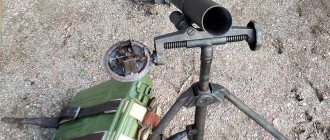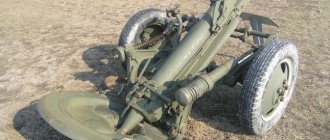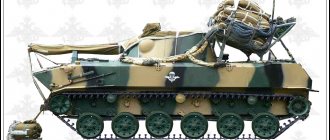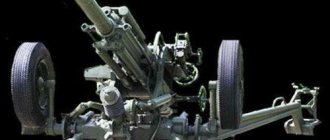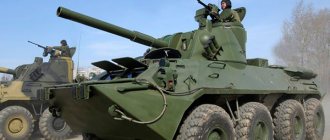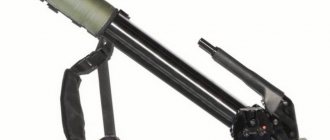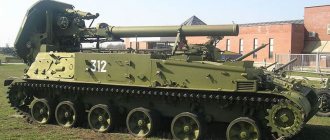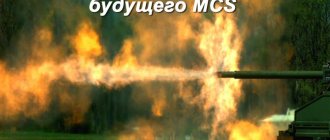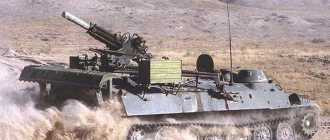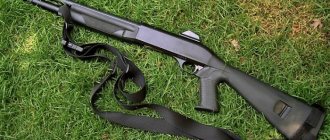120-mm towed breech-loading mortar NONA-M1
EQUIPMENT AND WEAPONS No. 6/2008, pp. 36-42
120-MM TOWED BREATCH-LOADING MORTAR “NONA-M1”
Semyon Fedoseev
Ending. For the beginning, see “TiV” No. 5/2008.
The material was prepared with the assistance of the 25th Department named after. A-G. Novozhilova FSUE "TSNIITOCHMASH"
Photos used
FSUE "TSNIITOCHMASH"
and from the editorial archive
The 120-mm towed rifled semi-automatic breech-loading mortar 2B-23 is intended for arming motorized rifle units of the Ground Forces (mortar batteries of motorized rifle battalions) and parachute units of the Airborne Forces. The mortar is towed by army vehicles with crews and ammunition, and is dropped by parachute on standard airborne parachute platforms.
The mortar ensures the destruction of various targets: enemy manpower (including personal armor protection); its fire weapons, located openly and located in uncovered field-type shelters, on steep reverse slopes of heights, in deep ravines, in gorges, forests; openly located light-weight armored objects (infantry fighting vehicles, armored personnel carriers, infantry fighting vehicles, self-propelled missile systems); command and observation posts of motorized infantry (infantry) units; squads (platoons) of 81-120 mm towed and self-propelled mortars; destruction of trenches, trenches, communication passages and light wood-earth structures.
2B-23 can fire from closed firing positions, both prepared and unprepared, with different types of soil (including swampy and soft soils with appropriate equipment for firing positions), at any time of the year and day.
In the Ground Forces battalions, the new mortar should replace the old, well-deserved 120-mm mortar PM-38 (regimental mortar model 1938 and its modifications). The paratroopers are currently planning to use the 2B-23 mortar to train crews of Nona-S self-propelled guns. However, the transfer of a mortar by a transport helicopter along with a tractor, ammunition and crew can ensure the combat use of the Nona-M1 in the Airborne Forces. Combined with the ability to be towed by light vehicles and select a position on rough terrain, this makes the mortar interesting for mountain motorized rifle units.
It is curious that the 2B-23 mortar was also of interest to the Ministry of Emergency Situations: a relatively light weapon, delivered by helicopter, firing at high elevation angles with fairly good shooting accuracy and the power of the ammunition, can be very useful in the fight against avalanches and ice jams.
Mortar device
The mortar is made according to a rigid design with the recoil force absorbed by the soil through the base plate. The mortar consists of five parts: a barrel, a frame with a breech, a two-legged carriage with wheels, a base plate, and an MPM-44M sight.
The barrel part consists of a barrel, a clip, a stopper, a bolt, a retainer, and a pivot foot. The barrel is a pipe with a rifled channel; in the breech it has a cylindrical chamber and an obturating slope. The rifled part of the barrel has 40 grooves of constant steepness. The beginning of the rifling in the breech has bevels in the form of bevels on the side edges of the rifling fields - these starts make it easier to insert the protrusions on the leading flange of the projectile into the rifling during loading. A pin paw is attached to the muzzle of the barrel for coupling the mortar with the car and for the convenience of rolling the mortar by crew forces, and on the breech there is a clip that serves to connect the barrel to the breech, as well as to attach the bolt and retainer. The stopper serves to secure the bolt to the holder, ensure rotation of the bolt when closing and opening it, as well as fixing it in the open position. The barrel part is hingedly connected to the frame with the breech and, together with it, is installed by a ball joint in the base plate.
The bolt in the Nona family of guns is perhaps the most original unit. In interaction with the frame and the breech, it ensures the final delivery of the shot into the barrel, closing and locking the barrel and firing the shot. The bolt consists of a rolling pin, a frame with a shutter, a striker, a striker return mechanism and a striker locking mechanism. An elastic-plastic seal of the Banja type consists of a cushion (a wire-reinforced asbestos shell filled with a rubber mass and compressed into a disc-shaped shape), front and rear split rings, two central rings, six small rings and six bushings. The position of the striker in the bolt, unlike the early Nona guns, depends little on the condition of the seal, or more precisely, on temperature changes in the size of the seal pad. This makes it easier for the crew to adjust and maintain the gun (mortar). However, for reliable obturation of powder gases during a shot, the seal pad must fit tightly to the obturator slope of the barrel. Such a tight fit is ensured by selecting seal discs of various thicknesses from a group set of spare parts.
Mortar 2B-23 in the firing position on wheels (at a high elevation angle).
The muzzle of a mortar barrel with a pivot foot. The rifling in the bore is clearly visible.
The frame with the breech combines into a single whole the barrel part, the base plate and the two-legged carriage with wheel travel and consists of the following parts: a stock in which the barrel is attached and which is connected to the frame by axles; frames with a stopper and a bar attached to it; pusher; a swivel with a sight bracket mounted on it; the breech, to which the plate stop, pedal, trigger lever, bracket and stop are attached.
| Mortars 2B-23 in the loading position. | At the end of the rotation of the barrel part, the bolt is retracted to the left and frees the chambering line. |
The barrel mounted in the stock rotates in a vertical plane for loading. To reduce the impact of recoil forces when firing on the two-legged carriage and the sight, spring shock absorbers are installed on the frame with the breech. The opening mechanism includes a firing plate with a protrusion to lock the barrel in the locked position. The firing plate contains a striking mechanism designed to strike the firing pin and includes a firing pin and a mainspring. The trigger mechanism is activated by a rotating lever.
The two-legged carriage with torsion bar wheel suspension is connected to the frame with a quick-release coupling. On the axis of the two-legged carriage there are guidance mechanisms that ensure that the barrel part is given the specified vertical and horizontal guidance angles. The guidance mechanism has the ability to move along the axis as a result of the interaction of the gear (receiving rotation from the handle through a worm drive) with a rack cut into one of the axis splines. There is also a leveling mechanism. The screw lifting mechanism with a double screw is mounted on the carriage of a two-legged carriage. Two rods are inserted inside the axle, at the ends of which openers are fixed, and axles with balancers are inserted into the rods, on which the wheels are fixed. The balancers are connected to torsion bars.
A two-legged carriage with the mortar in position for firing with support on the openers: on the left - with the wheels on, on the right - with the wheels removed (with an increased track width).
Mortar 2B-23 in loading position:
1
— barrel part;
2
- two-legged carriage with wheels;
3 — sight stand; 4 — MPM-44M sight; 5- sight bracket; 6 - key; 7 — frame with breech; 8
— rod;
9 — handle; 10
- shutter;
11
— cable;
12
— cord with carabiner;
13
— bracket;
14
— base plate;
/5 - emphasis; 16-18
— handles;
A
- emphasis.
The significant features of the two-legged carriage include variable travel width: due to the horizontal movement of the rods, it is possible to change the track width and thereby adapt the mortar to towing by various vehicles. The mortar can be fired with the wheels on or off. The last type of shooting is considered the main one, in which the wheel drive axis is rotated so that the coulter supports rest on the ground.
The welded base plate, as in any mortar, is designed to transmit the recoil effect of a shot to the ground and ensure the stability of the mortar when firing. The base plate currently used is a plate for the 2S12 (Sani) mortar complex with three openers and an additional ring welded onto it. The rotating insert provides horizontal guidance of the mortar within 360° (with rearrangement of the two-legged carriage). The stove has six carrying handles.
Mortar base plate lowered to the ground.
2B-23 is equipped with removable electrical equipment. When towing a mortar, it serves to transmit signals from the vehicle to the mortar's side lights, turn and brake indicators.
In total, the design of the 2B-23 mortar includes 343 parts. The mass of the mortar in the combat position is about 420 kg, in the stowed position - 514 kg. For comparison: 120-mm regimental mortars mod. 1938 and arr. 1943 had a mass in combat position of about 275 kg, and in stowed position - 560 kg.
The MPM-44M optical mortar sight is a modification of a standard mortar sight that has long been familiar to military artillerymen. It consists of a sighting device and a guidance mechanism (goniometer mechanism and elevation angle mechanism), mounted on a sight bracket or on a sight stand. The sight has a magnification factor of 2.55x, a field of view of 9°, the range of angles measured with it (in thousandths) in the horizontal plane is 60-00, in the vertical plane - from 6-50 to 15-00. The scale division value of the protractor and elevation angle mechanism (in thousandths): rough - 1-00, fine - 0-01. In addition to the crosshair, the sight reticle includes a collimator scale. It is used when the sight is used in conjunction with a K-1 gun collimator (when there are no distant and clearly visible aiming points).
| Mortar 2B-23, prepared for towing. | MPM-44M sight mounted on a 2B-23 mortar. |
For rough aiming of the sight at the aiming point or target, the front sight and the slot on the left side of the sight sight body can be used. The LUCH-PM2M device is used to illuminate the reticle, coarse and fine aiming scales, levels of the MPM-44M sight, and K-1 collimator.
To control the fire of 2B-23 mortar batteries, standard ground artillery fire control equipment is used. Prospective developments will also receive similar applications. It can even be said that the effective use of the capabilities of the 2B-23 mortars (increased firing range and better accuracy than smooth-bore mortars, the ability to quickly open fire and a wide range of ammunition used) requires modernization of the complex of reconnaissance and control equipment.
For operation, maintenance and repair, spare parts kits are provided: single - for each mortar, group - for six mortars, repair - for 18 mortars.
Operation of parts and mechanisms of the 2B-23 mortar
The process of loading a mortar is as follows. To open the bolt for the first time, you need to press the pedal at the bottom of the mortar all the way with your foot, while the combat tile moves back and the barrel part is released. To bring the barrel into the loading position, it must be pulled by the handle. The rotation of the barrel part relative to the frame with the breech is facilitated by a spring-loaded rod acting on the stock boss in the direction perpendicular to the axis of the barrel bore, as well as the position of the center of mass of the barrel part in front of and above the axis of the trunnions. When the barrel part is rotated, a rod with a rod connected to the bolt rolling pin moves the bolt back, while the stopper roller, interacting with the figured groove, turns the bolt to the left and down in the process of longitudinal movement of the bolt. At the end of the rotation, the shutter is locked. As a result, the barrel is in the loading position, the loading line is free, and the retainer is lowered. When the bolt is open, by the way, the retainer can be manually locked in the raised position - for example, so as not to break it with a banner when cleaning the barrel.
Before loading, ammunition is prepared in the same way as the 2S9 Nona-S gun. The assembled shot is manually inserted from the breech into the barrel using a retainer. When the protrusion on the shell of the projectile rests on the entry of the barrel rifling, the loader turns the projectile slightly until the protrusions coincide with the rifling. When chambering, the ogival part of the projectile or mine lifts the retainer, which lets the shot through and, after chambering the shot, falls down and keeps the shot in the barrel from falling out. After this, the crew energetically lowers the barrel part by the handles down, while the rod pulls the bolt forward by the rolling pin, and the bolt, due to the interaction of the roller with the figured groove, turns to the firing line and, continuing to move forward, finally sends the shot into the barrel.
At the end of the movement, the bolt, with its ring and shutter, raises the retainer. At the end of the rotation of the barrel part, the bolt recesses the firing plate, which, in the lowest position, locks the barrel in the locked position. The mortar is ready to fire.
The shot is fired using a trigger cord passed through the hole in the bracket and attached to the trigger lever. When the cord is pulled, the cocking lever rotates, the firing pin moves back and, together with the pipe moving forward, compresses the mainspring. With further rotation of the lever, the trigger mechanism is lowered, the firing pin with the tip under the action of the mainspring moves forward, strikes the firing pin, which pierces the primer of the ignition charge of the shot. After the primer is punctured, the firing pin, under the action of the spring and the pressure of the powder gases, returns back to its original position. Under recoil, the mortar rolls back, transferring most of the recoil energy to the base plate.
At the end of the shot, after the projectile (mine) has left the barrel, the barrel part, along with the frame and breech, rolls forward under the action of the elastic forces of the plate and soil. In this case, the combat tile, under the influence of its own inertia, tends to remain in place and, thus, moves backward relative to the breech. This movement is used to release the barrel.
At the end of the roll, the forward movement of the barrel, the position of its center of mass (and without a shot in the breech, it, as already mentioned, is in front and above the trunnions) and the force of the spring-loaded rod move the barrel out of place and rotate it to the loading position. This is the work of the “semi-automatic” mortar. Further operation of the mechanisms and parts occurs in the same way as when the shutter was first opened. If for some reason (for example, compaction of the soil under the base plate and, as a consequence, the absence of its elastic action and rolling forward), the barrel part does not move to the loading position after firing, it must be moved to this position manually, as described for first loading.
Mortar 2B-23 in firing position at low elevation angle.
| Mortar 2B-23 in position in combat position at an elevation angle of 85°. | Mortar 2B-23 in position in combat position at an elevation angle of 40-42°. |
Mortar 2B-23 disassembled for transport (the wheels from the two-legged carriage have not yet been separated).
The crew of the 2B-23 mortar includes five people: commander, gunner, lock, loader, installer. To this we can add the driver of the car, with the only amendment that the towed 2B-23 mortar and its towing vehicle are not “tied” tightly to each other. That is, the mortar towing vehicle, if necessary, can be used to solve other problems, and if the vehicle is hit, the mortar can be hooked up to another one.
When towed by a car, the mortar is hooked to the hook of the car with a pivot foot on the barrel and secured with a chain of the muzzle cover. If it is impossible to tow (for example, on sharply rough terrain), the mortar can be disassembled into six parts without the use of tools, each of which weighs no more than 100 kg. For comparison: the weight of the barrel of the French MO-120-RT-61 mortar is 114 kg, the wheel carriage is 257 kg, and the base plate is 190 kg.
To disassemble the mortar into large parts, the crew transfers it to the firing position, after which the barrel part is separated from the frame with the breech, then the frame with the breech is separated from the two-legged carriage and the base plate. When assembling in position, first the frame with the breech is inserted into the plate, then a two-legged carriage with a wheel drive is attached, the barrel part is connected to the frame with the breech. Of course, with such a size and mass of parts, the crew can only transport a disassembled mortar over short distances and in several “walks”, or with the involvement of fighters from the supported unit (especially taking into account the need to carry ammunition). The calculation can also resort to disassembling the mortar (fortunately, it is done quickly) in the case of a large penetration of the base plate into the ground. Then, after disassembly, the slab remaining in the ground is removed by the cable using a car.
For mountain units, as well as for airborne units, it is important to be able to transport a mortar with crew and ammunition by a combat transport helicopter and land on a small area. True, mountain troops even today must rely on such a proven means of transport as pack horses, and parts of a disassembled mortar are “at the limit of the carrying capacity” of a horse for transportation in packs in the mountains.
A little about ammunition
To fire from the 2B-23 (Nona-M1) mortar, 120-mm rounds of guns of the Nona family with high-explosive fragmentation shells with ready-made rifling on the leading belt and with feathered mines from the ammunition load of 120-mm mortars can be used. This list includes shots:
— ZVOF54 with a high-explosive fragmentation projectile ZOF49;
— ZVOF55 with active-reactive high-explosive fragmentation projectile ZOF50;
— ZVOF54-1 with a high-explosive fragmentation projectile ZOF49 with an AR-5 fuse;
— 53-VOF-843B and ZVOF79 with high-explosive fragmentation mine OF-843B;
— ZVOF57 and ZVOF69 with high-explosive fragmentation mine ZOF36;
— 53-VD-843 with smoke mine D-843;
— ZVS24 with ZS9 illumination mine;
— ZV34 with an incendiary mine;
— ZVD16 and ZVD17 with smoke-smoking mine ZD14.
Foreign-made finned mines can also be used for 120 mm mortars.
New ammunition has also been developed for the Nona family guns. To increase the efficiency of fragmentation action, one of the new projectiles features a more uniform fragmentation of the body and an increased speed of fragmentation to 2500 m/s. Shots with new shells can also be included in the Nona-M1 ammunition load.
It is possible to use “Nona-M1” in combination with a controlled 120-mm mine similar to the mine of the “Gran” complex. But so far, modifications to the mine for firing from a rifled mortar and experiments with such firing, as far as is known, have not been carried out.
Shots for guns of the Nona family, including the 2B-23 mortar (shown with a mine
and shells in inert ammunition).
About other systems
The 120-mm mortar has long been loved by our army. 120-mm regimental mortar mod. 1938, developed under the leadership of B.I. Shavyrin, became one of the best examples during the Second World War. Its modernized model remained in service after the war. In 1955, the created B.I. was adopted for service. Shavyrin 120-mm mortar M-120, the firing range of which was increased from 5.7 to 7.17 km due to the use of a long-range charge.
At the end of the 1960s. 120-mm mortars in the Soviet army were transferred from the regimental level to the battalion level. This significantly increased the fire capabilities of the battalions, but at the same time required greater mobility from the 120-mm mortars.
At the Burevestnik Central Research Institute, a lightweight 120-mm Sani mortar system was developed for the M-120 ammunition, which was put into service in 1979 under the designation 2S12. The complex includes a 2B11 mortar, a 2L81 wheel drive and a 2F510 transport vehicle based on the GAZ-66-05 vehicle. The mortar is muzzle-loading, made according to the diagram of an imaginary triangle, with a detachable wheel drive. The mass of the mortar in the stowed position is 300 kg, in the combat position - 210 kg. The weight of the 2B11 mortar barrel is 74 kg, the two-legged carriage is 55 kg, and the base plate is 82 kg. Sighting devices include the MPM-44-04 sight, the K-1 gun collimator and the LUCH-PM2M device.
The “portable” nature of the mortar allows it to achieve high marching speeds—up to 90 km/h. But this requires a specially equipped vehicle (a winch, two ramps, and mounting devices for a mortar in the body). Taking into account the transportation of a mortar in the back of a vehicle, a crew of 5 people, and a single set of spare parts, only a small part of the ammunition can be placed on the same vehicle. So a separate vehicle is required to transport ammunition. The speed of towing behind a car on a highway is 60 km/h (for a range of no more than 30 km), and on rough terrain when changing firing positions in a hitch behind a tractor - no more than 20 km/h (for a range of up to 5-10 km).
Mortars. The deadly family of Aunt Nona and Uncle Vasily
A series of articles about mortars would not be complete if we did not talk about one of the most famous products - the universal 120-mm Nona gun.
We will not repeat the reasons for the success of mortars as such. But one reason still needs to be voiced. It's simple. The mortar and, most importantly, its ammunition are quite cheap to produce. Today, almost any state with a more or less developed industry can create such a weapon.
But only small and medium caliber mortars can be produced. To produce large calibers, a fairly high industrial and scientific potential is required. At the same time, the experience of Soviet gunsmiths in creating especially large-caliber mortars (see the article “Capacitor and Transformer.” Almost about mortars) showed that increasing the power of a mortar is only possible by increasing the power of the ammunition.
Speaking of post-war developments, it is worth mentioning the difficulties faced by designers around the world.
First. Lack of materials that could withstand the enormous loads experienced by a powerful mortar when fired.
Second. Speaking of self-propelled mortars, the problem of a truly reliable chassis arose.
Even theoretically possible versions of such a product ran into precisely the problem of lack of materials. Super-mortars, large-caliber and mobile, simultaneously remained the goal of many designers.
A solution has been found. And again the French found him. Perhaps without even knowing it. In the early 60s, the French adopted the 120-mm MO-RT-61 mortar.
There is no point in talking about this mortar in detail. But those, frankly speaking, revolutionary solutions that are there are worth considering.
First of all, the MO-RT-61 has a rifled barrel! And at the same time maintains muzzle loading. Something that was not in artillery before. The mines for this mortar were factory threaded on the driving belt. In addition, the new mortar used a special charger with a powder charge, which flew out along with the mine.
It is clear that such a projectile was met with hostility in the mortar units. Agree, inserting a mine with a thread on the belt is more difficult than simply throwing it into the barrel. This greatly increased the time between shots and required sufficient attention from the crew.
In addition, the problem of an “overstabilized projectile” appeared. When fired at high elevation angles, mines simply “didn’t have time to roll over.” In fact, these mines fell with their tail down.
What is the main disadvantage of the “classic” mine? The answer is paradoxical - in the mine itself! The very design of this projectile “discards as unnecessary” part of the ammunition. The fuse is in the head part. The bulk of explosives too. At the same time, the stabilizer and the adjacent part of the body either do not produce fragments at all, or they are large, heavy and, while producing the required number of fragments, at the same time affect the speed of the mine. In the direction of decreasing it.
Hence, when the mine is triggered, the main, most effective and high-speed fragments “go” into the ground. Simply put, the mine “really works” for about a third of its body.
In a stabilized mine, with factory threading, the explosives are distributed more evenly and the number of high-velocity fragments, according to artillery specialists from the Central Research Institute of Precision Engineering (TSNIITOCHMASH) in the city of Klimovsk, who tested the French mine, increases by 1.5 times.
Moreover, our engineers discovered what they had been looking for in large calibers without success. The power of a 120-mm rifled mine projectile in its combat properties was approximately equal to the power of a 152-mm mine!
Attentive readers have already noticed the “inaccuracy” of the authors. In the previous article we mentioned the developments of Americans in the 20-30s of the last century - XM70 "Moritzer" and M98 "Hautar" (the names are derived from a combination of the words "mortar" and "howitzer": MORtar - howiTZER and HOWitzer - morTAR). In principle, these developments can be attributed to what surprised the French. However, the Americans abandoned the idea due to its futility.
But let's return to TsNIITOCHMASH. It was the test results in Klimovsk that forced the Main Rocket and Artillery Directorate to begin developing a new weapon there. A universal weapon!
Here it is necessary to make a digression from the topic of the article.
The 70s of the last century were years of active work on the creation of the USSR Airborne Forces. The legendary commander of the Airborne Forces V.F. Margelov actively pioneered a new method of conducting military operations using airborne units and formations. Moreover, according to the commander’s idea, these should have been full-fledged units and formations capable of independently carrying out combat missions with a full range of weapons and equipment.
It was Margelov who saw the promise of a universal weapon for the Airborne Forces. And, in many ways, it was the commander of the Airborne Forces who “punched through” the development of this weapon in the amphibious version. By the way, these are not the only products for which V. Margelov became the “dad”. There were also “Violet” (122 mm self-propelled howitzer) and “Lily of the Valley” (120 mm self-propelled mortar).
The 122-mm divisional airborne self-propelled howitzer 2S2 “Violet” or object 924 was never accepted into service. One of the reasons was the high recoil of the 2A32 gun with the ballistics of the D-30 howitzer, which the modified BMD-1 chassis could not withstand.
A prototype of the Nona-D self-propelled gun, built on the 2S2 Fialka chassis. “Lily of the Valley” could look similar...
“Lily of the Valley” did not go into production; the project was stopped at the development level. But the work was done, and it was done for a reason.
In 1981, the Nona was put into service.
The appearance of this weapon in the airborne divisions caused a flurry of enthusiasm. Indeed, maneuverable, on the BTR-D chassis, the vehicle was “their own” for paratroopers. It floats, keeps up with the BMD on the track, and is lightweight (8 tons in the first version). The tower rotates +/- 35 degrees (officially). But, as soon as you disconnect the hoses of the pneumatic system, in manual mode it turns the “head” a full 360 degrees...
A weapon that can fire like a regular cannon. Moreover, against armored targets and with a cumulative projectile. True, going into battle with tanks, for example, is like death for “Nona”. Landing gun. Well, the landing armor... I mean, a bullet won’t penetrate.
A weapon that is a howitzer! Simply put, it fires conventional and active-rocket projectiles along a mounted “howitzer” trajectory.
A weapon that acts as a mortar when firing along a “mortar” trajectory. Moreover, “Nona” is a real mortar, it fires mines of any manufacture. By the way, this was one of Margelov’s conditions. The landing force had to operate behind enemy lines. Moreover, the Nona is a mortar more accurate than most mortars of the same caliber. The breech of the gun “extends” the barrel.
"Nona-M" (2006)
Combat weight, t: 8.8(2S9-1M) Landing weight, t: 8.2 Crew, persons: 4 Armor, mm: 16, aluminum
Engine power, hp: 240 Speed, km/h: 60 Speed afloat, km/h: 9 Cruising range, km: 500
Armament: rifled, semi-automatic gun-howitzer-mortar 120-mm 2A51M
Ammunition, pcs: 40 during landing, pcs: 25
Time to open fire on an unscheduled target, min: 0.5-0.9
By the way, it’s quite spacious inside. There is a certain expectation to see quite amphibious guys in the crew, and not tankers.
The success of the Nona 2S9 self-propelled gun accelerated the development of a towed version of the gun.
The option is almost identical to “None-S”, but with a different name. 2B16 "Nona-K".
Attentive readers immediately noticed some discrepancy in the title. domestic towed guns have the letter “B” in the designation. And here is "K". The towed version of the Nona entered service in 1986.
We have been looking for an explanation for the word “Nona” for quite some time. There are many options, but there is no 100% answer. Most likely, the name was chosen “for reasons of secrecy.” But this is just our opinion. Just like the fact that the classic designation of the “Nona-B” gun would sound quite interesting to our army jokers.
Moreover, “Nona” went into the infantry. The ground forces, taking into account the specifics of their own armored vehicles, ordered the Nona version for themselves. The gun-howitzer-mortar “moved” from the BTR-D to the BTR-80. In this version it is called 2S23 “Nona-SVK”. Accordingly, she changed her status. For a battalion self-propelled artillery gun. Adopted into service in 1991.
There is also a towed version 2S23 Nona. This weapon can already be seen today in... the Ministry of Emergency Situations. Lightweight and capable of being transported by helicopter, the weapon is successfully used in the mountains and when extinguishing fires in the taiga. The 2S23 “Nonu-M1” is also used to clear ice jams on rivers.
In general, if we talk about universal weapons, “Nona” should have been called “Eva”. An excellent weapon, but the first. Parent (if she has a female name). And he already has a “baby”. Daughter.
True, the name of the “daughter” is not entirely traditional - “Vienna”. Full name: 120mm self-propelled artillery gun 2S31 “Vena”. The gun has been in operation since 2010.
The fundamental difference from the Nona for this weapon is automation. There is a computer on board that controls the entire complex. In practice, the self-propelled gun operates in automatic mode. From receiving a command via telecode communication channels to automatically firing a weapon at the target. In addition, the complex automatically controls guidance after a shot.
The 2S31 also has a number of systems that help the crew in their work. These include topographical reference systems for guns, reconnaissance and target designation systems, and a laser rangefinder for automatically determining the distance to the target. At the same time, the possibility of manual control is fully preserved.
The gun is now located on the BMP-3 chassis. This made it possible not only to increase the ammunition load to 70 rounds, but also to create a mechanism for quickly damping body vibrations after a shot. Which, in turn, allows you to fire several shots without changing the sight.
Combat weight, t: 19.8 Crew, people: 4
Armament: 2A80 cannon, PKTM machine gun Ammunition, pcs: 70
Engine power, hp: 450 Speed, km/h: 70 afloat: 10 Cruising range, km: 600
The airborne troops decided to follow the path already mastered by motorized rifles. And, according to rumors, the paratroopers are demanding the “Vena” in the “Crimp” version. Only in contrast to the land version, the Airborne Forces want to “transplant” the “Vena” onto the BMD-3. So we are waiting for your birthday.
The potential of universal weapons is only just being revealed. The future for this weapon is bright. Especially considering the latest developments in ammunition for such guns...
P.S. Rocket launchers are on their way!

